The Flim Flam Man
The Flim Flam Man, directed by Irvin Kershner and released in 1967, is a remarkable film. It blends elements of comedy and drama.
Our own masters, an all the things, on our side. Partner, I tell ya things are gettin’ brighter. As I look ahead to the prospects, I can see the multicolored arch of the rainbow of good fortune.
Mordecai Jones
Introduction
The 1967 film, The Flim Flam Man, directed by Irvin Kershner (1923-2010) and produced by Lawrence Turman (1926-), is a remarkable work of art. It blends elements of comedy, drama, and adventure to deliver a captivating story of deception and redemption. Set in the American South during the 1960s, the film takes viewers on a thrilling journey. The protagonist is Mordecai Jones, portrayed by the renowned George C. Scott (1927-1999). The film has an engaging narrative, well-crafted characters, and thought-provoking themes. The Flim Flam Man remains a timeless cinematic gem.
At its core, the film explores the art of the con and the complex nature of human relationships. Mordecai Jones, a seasoned con artist, becomes a mentor to a young drifter named Curley, portrayed by Michael Sarrazin (1940-2011). Together, they embark on clever scams and schemes that test their skills and challenge their moral compass. As the story unfolds, viewers see a world of deception, where trust is elusive and motivations are often masked.
One of the film’s strengths is its authentic portrayal of the American South during the 1960s. The setting serves as a backdrop that adds depth and richness to the narrative. It captures the era’s essence and provides a unique context for the characters' actions and motivations. The detailed production design, costumes, and cinematography capture viewers.
Central to the film’s success is George C. Scott's exceptional performance as Mordecai Jones. Scott brings charisma, charm, and depth to the character. He captures the essence of a seasoned con artist with a troubled past. His portrayal showcases the complexities of Mordecai’s personality. He transforms between cunning manipulation and genuine moments of vulnerability. The chemistry between Scott and Sarrazin delivers a compelling performance.
The Flim Flam Man delves into deeper themes of trust, morality, and the power of redemption. It explores the transformative journey of its characters as they navigate a world built on deception. They come face-to-face with the consequences of their actions. Through the twists and turns of the plot, the film prompts viewers to question their beliefs and perceptions. It challenges viewers to reflect on the boundaries of morality and the potential for personal growth.
The filming occurred in various locations in Kentucky, United States. The picturesque rural landscapes and small-town settings contribute to the authentic Southern atmosphere. The production team used the region’s natural beauty and charm to bring the story to life. As a retired railroader, the train scenes warm my heart.
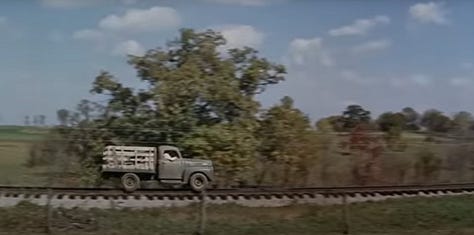
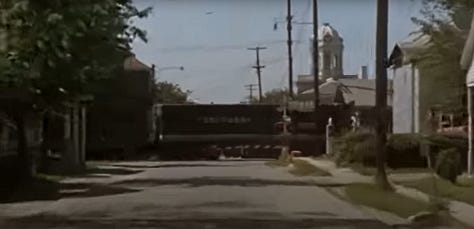
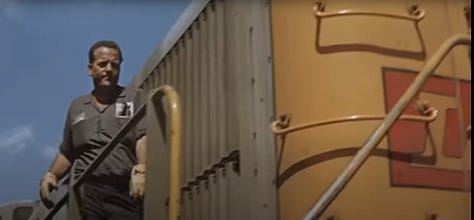
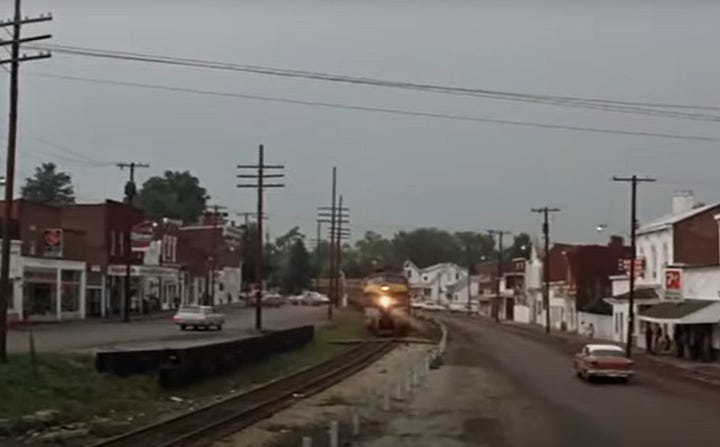
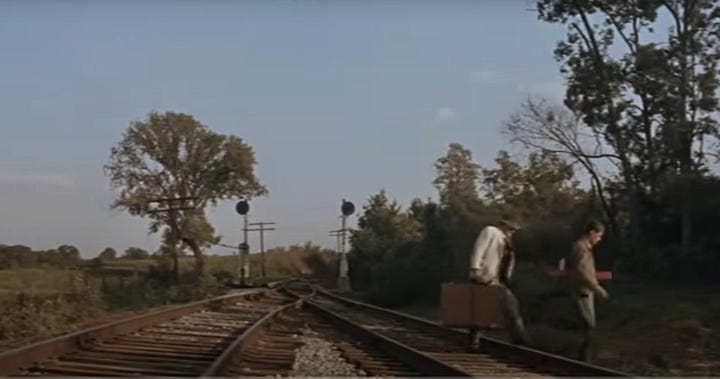
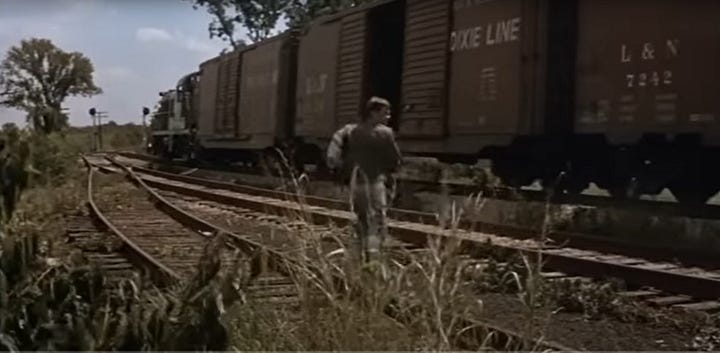
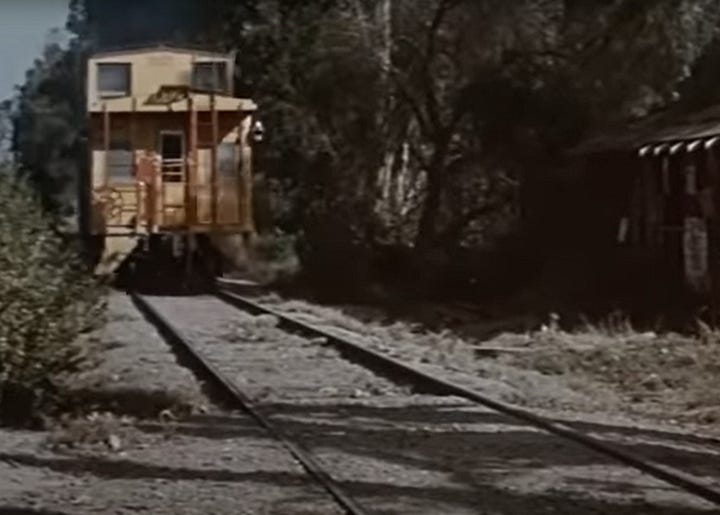
Growing up in the 1960s also inspires me with beautiful memories of that time in history, as depicted in the film. After watching it uncounted times and taking notes, I hope you enjoy my rendition of The Flim Flam Man. It is right up there with my all-time favorite, 2001: A Space Odyssey. Each scene title includes a link to that time frame in the film. Get the popcorn.
Scenes
One - Railroaded
Curley, a character running from the authorities, finds himself next to a passing Louisville & Nashville Railroad freight train. A sudden occurrence catches his attention as he prepares to swing himself into a boxcar of a moving train. A man and his suitcase in a scuffle get expelled from the boxcar ahead of him. In this initial glimpse into Curley’s compassionate nature, he foregoes boarding the train. He jumps off the train’s side to aid the older man, Mordecai Jones.
Curley assists the man to his feet, demonstrating his willingness to lend a helping hand. Together, they gather the scattered contents of the suitcase, working side by side to ensure all items get collected. In this moment of unexpected unity, the duo sets off on a journey. It takes them through the dense woods, their journey veiled in mystery and uncertainty. This encounter between Curley and Mordecai symbolizes human connection and empathy.
Through this poignant opening scene, The Flim Flam Man sets the stage for the themes of compassion and camaraderie. The search for redemption permeates the story. Despite being a stranger and facing challenges, Curley’s decision to assist the man hints at the moral complexities.
Two - Caboose Sanctuary
After their unexpected encounter on the train, Curley and Mordecai find themselves on a journey. It takes them to the secluded refuge of Curley’s hidden sanctuary—a wrecked and abandoned caboose in a creek bed. Seeking solace within the walls of this forgotten relic, the duo seeks temporary respite. It protects them from the chaos of the outside world and the troubles that haunt them.
A sense of serenity envelops them as they step inside the weathered caboose. It is a place frozen in time, a testament to forgotten days of train travel and the stories it carried along the tracks. Within the worn and faded interiors of the caboose, Curley and Mordecai find solace, if only for a night, from the burdens that weigh upon them.
It becomes evident to Mordecai that Curley is on the run, seeking refuge from the long arm of the Military Police. He is a wanted man for striking a sergeant. The caboose becomes a sanctuary where Curley can escape the imminent threat. Ever astute and observant, Mordecai picks up on the tension that hangs in the air, the unspoken fears and desires that drive Curley forward.
Curley and Mordecai share stories, fears, and hopes inside the humble shelter. Their friendship deepens as they find solace and understanding in each other’s presence. The caboose becomes more than a physical structure; it symbolizes their shared journey. It is a place where they can unburden their souls and find a sense of camaraderie. Within this tranquil setting, Curley and Mordecai forge a bond. It transcends the troubles that brought them together.
Three - Three Card Monte
As the morning dawns, Curley and his newfound companion venture to a nearby general store. Here, Mordecai, the consummate trickster, employs his skillful sleight of hand. He orchestrates the age-old deception of three-card Monte. He manipulates the playing cards with nimble fingers, enticing unsuspecting onlookers. Meanwhile, Curley assumes the store owner’s role, drawing potential victims’ attention and trust.
Their target this time is the store owner Tetter, portrayed by George Mitchell (1905-1972), who becomes entangled in their intricate web of deceit. Mordecai’s masterful manipulation of the playing cards leads the store owner. Selecting the queen of hearts is a “winner.” Succumbing to the allure of a potential victory, Tetter places his bets. He is unaware he is falling into the clutches of cunning con artists.
The outcome is inevitable—the store owner gets taken for $42.00, a significant amount for that time. Through their calculated collaboration, Mordecai and Curley exploit Tetter’s trust. This illustrates the duo’s expertise in the art of deception and their ability to capitalize on human vulnerability.
This pivotal moment in the film showcases Mordecai’s world's deceptive allure and moral ambiguity. The sequence also highlights the dynamic partnership between the two characters.
Four - Salime Sandwich
Returning to their makeshift home in the caboose, Mordecai and Curley revel in the spoils of their successful con at the general store. The atmosphere is light-hearted as they indulge in a satisfying meal of salami and ham sandwiches. They relish their ill-gotten gains. Their moment of contentment gets shattered when a group of angry men from the store disrupts their makeshift haven.
Five - Train Station Sleep
Following their daring escape from the group of angry men from the store, Curley and Mordecai seek refuge. They end up in the crumbling structure of an abandoned train station. As they take shelter within its dilapidated walls, a sense of weariness and realization settles upon Curley. It dawns on him that he is now in the company of the renowned Flim Flam Man himself.
The train station, once a bustling hub of activity, now stands as a reminder of bygone days. Its weathered facade bears witness to the passage of time, and the echoes of long-forgotten footsteps linger in the air. Inside, the scent of musty air mixes with the dust of forgotten dreams, creating an atmosphere of both melancholy and possibility.
Six - MP Encounter
After resting for the night, Curley and Mordecai know they must resume their journey and leave the train station. With a sense of urgency and caution, they set out on foot along a rural road, their sights set on the next engagement that awaits them. In the distance, the faint hum of a motor grows louder, signaling the approach of a Jeep carrying Military Police.
Reacting, Curley and Mordecai dive into the camouflage of the nearby woods. Their hearts pound in their chests as they observe the military Jeep pass by. Its fleeting presence is a constant reminder of the ever-present danger that lurks around them.
Relieved that they have evaded immediate capture, the duo emerges from their hiding place as the Jeep fades. Their respite is short-lived, as the local sheriff’s patrol car soon appears. They jump back into the brush. Suspicion dances in the sheriff’s eyes as he glances in their direction, his instincts piqued. Yet, after a momentary pause, he thought it was an animal.
Curley and Mordecai traverse the open field before them to avoid further road encounters. Each step brings them farther away from the looming threat and closer to the promise of their next engagement. Their determination fuels their movements as they navigate the uneven terrain, their eyes focused on the path ahead.
Seven - Preacher Perpetrator
The following scheme undertaken by Mordecai and Curley becomes the pivotal centerpiece of the film. It is teeming with intricate details and extensions. In this elaborate ruse, Mordecai, accompanied by his young companion, assumes a preacher’s identity. Mordecai dresses Curley as a car accident victim who urgently needs medical attention. This scheme reaches its climax when they orchestrate the theft of a vibrant red convertible from a young girl. Bonnie Lee Packard, portrayed by Sue Lyon (1946-2019), and her mother, Mrs. Packard portrayed by Alice Ghostley (1923-2007), are the victims.
Mordecai and Curley manipulate the situation; they exploit compassion and goodwill. They deceive Bonnie Lee and her mother into relinquishing their prized automobile. The absurdity is not lost on Bonnie Lee’s mother, who exclaims, “Well, I declare! If the clergy ’round here’s gonna start stealin’ ever’body’s au-to-mo-bile—.”
This moment encapsulates the film’s blend of humor and moral ambiguity. Bonnie Lee’s mother expressed disbelief and a touch of admiration for the con artists' audacity. It reflects the exploration of trust, deception, and the blurred lines between right and wrong.
Eight - The Chase
The stolen red car races through the county. The local sheriff, “Zeb” Slade, portrayed by Harry Morgan (1915-2011), and his bumbling deputy, Meshaw, portrayed by Albert Salmi (1927-1990), recognize the speeding vehicle and give chase. The pursuit unfolds, escalating the tension and propelling the narrative forward.
With Mordecai behind the wheel, his skilled maneuvers and quick thinking allow them to escape capture. The high-speed chase leaves a trail of chaos and destruction in their wake, turning the nearby town into a scene of havoc. In a moment of misfortune, the stolen car collides with the Dodge belonging to Bonnie Lee’s father, portrayed by Jack Albertson (1907-1981).
Amidst the chaos, Mordecai reflects on the repercussions of their actions. He comments with a mix of wry humor and self-awareness, “Yep, I’d say they’ll remember us in Clayton.” His remark encapsulates the consequences of their reckless behavior. It acknowledges their actions have left an indelible mark on the town and the people they encounter.
This scene is pivotal in the film, intensifying the conflict between the law enforcement officers and con artists. It also highlights the destructive nature of Mordecai’s schemes and their ripple effects on the lives of those around him.
Through this sequence, The Flim Flam Man delves into the themes of accountability and the cost of deception from actions. It reinforces the film’s exploration of the blurred lines between right and wrong. It illustrates the far-reaching consequences of pursuing one’s desires without regard for others.
Nine - Moonshine on the Rails
Forced to abandon the wrecked stolen convertible, Mordecai and Curley find themselves again on foot. The determined Sheriff Slade and Deputy Meshaw are in pursuit. In a stroke of luck, Mordecai and Curley stumble upon Doodle Powell’s moonshine still. Of note, there is a blooper in the film’s editing. Curley is right behind Mordecai when Powell points his pistol. The film transitions with Curley out of view and yelling. Mordecai tells Powell it is the police, and Powell runs.
The duo seize the opportunity and decide to make their escape using a different vehicle—Powell’s 1948 Ford pickup truck. With the cigar-smoking sheriff and Meshaw hot on their trail, they speed away in the stolen truck. Their path ends as they reach a dead end—a dirt road ending at a railroad track. Mordecai instructs Curley to deflate the truck’s tires to half pressure, a cunning move to hug the rails and maximize traction. Wedging the pickup truck onto the rails, they embark on a daring escape, utilizing the tracks as their makeshift path.
Reveling in his cleverness, Mordecai boasts about their innovative escape plan while operating the pickup on the tracks, referring to it as a unique way of “making tracks.” Their on-track journey is short-lived as an approaching train threatens to derail their escape. Faced with imminent danger, Mordecai maneuvers the truck off the track with a rapid right turn. They avoid a head-on collision with the oncoming train. The truck tires are fully inflated at this point (a blooper).
Meanwhile, Sheriff Slade finds his way to the track where the duo took to the rails. Mystified that the tire tracks end at the railroad, Slade thinks he is trailing Doodle Powell. He claims that Powell’s pickup is one of those “am-fam-fib-ious” vehicles that crossed the river beside the railroad.
This scene exemplifies the film’s skillful blend of action, humor, and clever twists. It showcases the protagonists’ ability to think independently and their unwavering determination to stay one step ahead of the law. It highlights the juxtaposition of their audacious schemes against the backdrop of a rural landscape. It is adventure and survival within the setting of a classic chase.
Ten - Supermarket Resale
Mordecai and Curley find themselves at a supermarket at their next destination. Mordecai, ever the master of deception, enters the store and proceeds to make a few purchases. Assuming a German accent, Mordecai manipulates the market’s manager, portrayed by Woodrow Parfrey (1922-1984). He unconventionally settled his large $136.40 bill for clothes, food, and hardware.
While in the store, Curley calls Bonnie Lee. She answers, and Curley tells her that he will pay for the damage to her car. She tells him he must also pay for her father’s car, which they ran into in town during the chase. Bonnie Lee’s mother calls for her. She says to Curley, “I have to go, Rosco.” That signals she is using a known name as a cover for the phone conversation.
Meanwhile, the duo leads the market manager to the pickup truck at the back of the store. Mordecai takes out a jazzed-up bottle of Powell’s white lightning for the proprietor to sample. Using his cunning wit, Mordecai convinces the unsuspecting market manager to purchase 58 bottles of white lightning in the pickup truck. That transaction paid for the goods purchased by the duo, with an additional $37.60 owed to Mordecai.
The market manager, driven by his desire for profit, falls prey to Mordecai’s charismatic manipulation. He exchanged his merchandise for a collection of spirits. The scene serves as a reminder that the line between the con artist and the conned is often blurred. Both parties become entangled in a web of deception.
Mordecai’s use of a German accent adds more complexity to the scene. It showcases Mordecai’s versatility and ability to adapt his persona to suit the needs of each con, highlighting the character’s chameleon-like nature.
Eleven - The Love Interlude
After their successful exploits at the general store, the duo ends up in their latest secluded camp. Curley’s thoughts turn to Bonnie Lee. Fueled by curiosity and longing, he sets off to visit her, his mind filled with visions of what could be.
Bonnie Lee, resting on the porch, sees Curley in the yard. They go to the barn for privacy. He promises Bonnie Lee he will pay for the damages, but it will take time. They embrace in a compassionate kiss. It is a fleeting glimpse of normalcy, a glimmer of hope in a world that often seems devoid of such possibilities.
Bonnie Lee’s father called for her. Curley said he would phone her, and she returned to the house.
Twelve-Punch Board
Mordecai seizes another opportunity for a profitable scheme at a different store. He approaches the store manager, Lovick portrayed by Strother Martin (1919-1980), and offers him a chance to buy a $1.00 punch board. This simple yet enticing game promises the possibility of winning valuable prizes.
Unbeknownst to Lovick, Curley possesses insider knowledge of the punch board. With this advantage, Curley follows behind Mordecai and selects the winning punches, securing $20.00 in winnings.
This scene showcases the duo’s exploitation of human nature and ability to manipulate the desire for quick and easy gains. Mordecai’s salesmanship and Curley’s calculated actions exemplify their skills.
This scene adds to the film’s narrative and provides further insight into the characters’ motivations and methods. It reinforces the underlying themes of deception, opportunism, and the blurred lines between right and wrong.
Thirteen - The Farmhouse
Curley felt a stirring deep within him as the dust settled after the Punch Board scene. Determined to confront the ghosts of his upbringing, he embarked on a poignant journey to his parents’ long-abandoned farm along with Bonnie Lee.
Arriving at the dilapidated farmstead, Curley commiserated a mixture of nostalgia and trepidation. The once-thriving homestead now stood as a solemn reminder of bygone days. Weeds and wildflowers had claimed the once-pristine garden.
Curley and Bonnie Lee ventured into the overgrown fields surrounding the farmhouse. He said, “Tobacco, corn, and kids are the principal crops in this County.” There, Bonnie Lee told Curley that he was working with an “Awful old man” and that he should turn himself in to the authorities.
Thirteen - M.B.S., C.S., D.D.
As a ferry glides across the water, Mordecai describes himself with his trademark charisma. He is a self-styled “M.B.S., C.S., D.D. – Master of Back-Stabbing, Cork-Screwing, and Dirty-Dealing!” The words roll off his tongue with pride and mischief, capturing the essence of his craft and the audacity with which he operates.
At this moment, Mordecai reveals his skills as a con artist, self-awareness, and playfulness. The acronym he creates for himself showcases his cunning nature and adeptness at manipulation. Mordecai establishes himself as a formidable figure in trickery and cunning.
The ferry ride provides a momentary respite from schemes and scams. It allows Mordecai time to reflect on his chosen path with a mix of pride and amusement. As he delivers his declaration with a twinkle in his eye, it becomes evident that Mordecai thrives on the thrill of his chosen profession.
This scene not only adds depth to Mordecai’s character but also sets the tone for the rest of the film. It hints at the exciting and unpredictable journey ahead. Mordecai’s proclamation serves as a compelling invitation to the audience. It invites us to join him on a captivating ride filled with twists, turns, and unexpected revelations.
Fourteen - Pigeon Drop
The most impressive and elaborate scheme in Mordecai and Curley’s repertoire is the “found wallet” ploy, a classic con known as the pigeon drop. This orchestrated scam involves executed distractions and masterful sleight-of-hand. These maneuvres distract the unsuspecting target.
Jarvis Bates portrayed by Slim Pickens (1919-1983) becomes the “target.” With their well-honed skills, Mordecai and Curley create an elaborate scenario to entice their victim. Jarvis believes he has stumbled upon a lost wallet containing a large sum of money. They convince their mark of the wallet’s authenticity and good fortune. The duo incorporates a series of calculated misdirections and timed movements.
As Jarvis becomes convinced of the genuine nature of the discovery, Mordecai and Curley extract a handsome profit of $500.00 from their unsuspecting victim. This impressive feat of manipulation and deception showcases their expertise in the art of the con and emphasizes the psychological dynamics at play in their interactions with their targets.
The “found wallet” ploy is the pièce de résistance of their scams, representing the pinnacle of their craft and demonstrating their ability to exploit human vulnerabilities. Including an actor like Slim Pickens adds another layer of authenticity and depth to the scene. His portrayal of Jarvis enhances the believability of the scenario, creating a dynamic interplay.
Fifteen - The Campsite
After the pigeon drop, Mordecai and Curley go to their secluded campsite. Curley says he wants out of the partnership as he laments not working for an honest buck. They argue, and Curley tells Mordecai, “I do not want to end up like you.” They then go to sleep for the night.
The peaceful reverie ends the following morning when Sheriff Slade and Deputy Meshaw end Mordecai and Curley’s sleep. Their pursuers have finally caught up with them, ending their escapades.
The arrest lands Mordecai and Curley behind bars, confined to a jail cell. This turn of events marks a significant shift in their journey as they transition from being the pursuers to becoming the pursuers. There is a stark contrast between the idyllic moments of reflection and the harsh reality of their capture, which highlights the precarious nature of their chosen lifestyle.
The scene encapsulates the film’s exploration of consequences and the cyclical nature of actions. It serves as a pivotal moment in the narrative, where the characters confront the ramifications of their choices.
Furthermore, the inclusion of Sheriff Slade and Deputy Meshaw adds a sense of justice and retribution to the story. The persistent pursuit and eventual apprehension contribute to the film’s underlying themes. The presence of law enforcement serves as a reminder that deceit and illegal activities come with a price.
Sixteen - Jailhouse Jinks
There is one final trick up their sleeves. This last scheme is the culmination of Curley’s apprenticeship under the esteemed guidance of the master con artist, Mordecai Jones. Curley’s evolution as a skilled con artist becomes evident as he proves himself a worthy student of the craft.
In a display of cunning and deception, Curley devises a plan to hoodwink the gullible and manipulate the situation to their advantage. He pretends to rat out Mordecai, spinning lurid tales of a murderous career to captivate the attention of Sheriff Slade. This strategic move distracts the sheriff, allowing Curley to escape. Stealing a sheriff’s car, Curely makes another visit to see Bonnie Lee. He convinces her he must find a way to secure Mordecai’s freedom.
He returns to the scene, placing wired dynamite boxes around the town hall jail. Bonnie Lee and her father came to the scene and watched from the background. Armed with a plunger, Curley threatens to blow everyone up unless Mordecai gets released. This high-stakes ploy demonstrates the lengths Curley is willing to go to protect his partner. The final goodbye between Mordecai to Curely includes Mordecai tipping his hat to Bonnie Lee. Mordecai gets to escape in the sheriff’s automobile. Meanwhile, the deputy calls the state police to blockade the county.
Bonnie Lee’s father looks on with tacit approval of Curley’s determination and willingness to accept the consequences. He tells Bonnie Lee he will help and get the best lawyers to represent Curley.
As the tension peaks, Mordecai makes a pre-arranged three-ring call from a nearby phone booth, signaling to Curley that he is safe. Mordecai had ditched the Sherif’s car to avoid the county roadbook and remained nearby in the shadows. At this pivotal moment, Curley reveals that the plunger is a prop, not wired to explosives. It is a masterful display of psychological manipulation and calculated risk-taking. Their operation was an orchestrated plot. It highlights Mordecai’s role as the orchestrator and strategist.
This climactic scene encapsulates the film’s exploration of trust, loyalty, and the bond between partners in crime. It showcases Curley’s growth as a con artist. It also underscores Mordecai’s strategic brilliance and mentorship. The sequence also emphasizes the risks and consequences inherent in their chosen path.
Seventeen - The End
The film comes full circle as it concludes with a scene reminiscent of its opening. Now alone, Mordecai, using a bicycle to move about, finds himself at a railroad crossing. He leans the bike against a wooden crossing sign (crossbuck) post with carefree confidence, a subtle sign of his resourcefulness and ability to adapt to any situation.
As Mordecai stands at the crossing, a freight train rumbles by, positioned between him and the camera. The passing train symbolizes the transient nature of his life, always on the move and never rooted in one place for too long. It echoes the themes of freedom, adventure, and constant change throughout the film.
Once the train has passed, the bicycle remains at the crossing. It symbolizes Mordecai’s journey, transient existence, and the traces he leaves behind. This closing scene leaves the audience with a sense of intrigue and contemplation. It invites reflection on the nature of Mordecai’s character, his choices, and the consequences of his actions.
Conclusion
The Flim Flam Man is a timeless cinematic masterpiece. It blends comedy, drama, and adventure to craft a thought-provoking narrative. It is a remarkable performance of its cast, led by George C. Scott’s portrayal of Mordecai Jones. The film presents a compelling exploration of trust, morality, and redemption. It immerses viewers in a world of deception and charm. With the plot, we question the boundaries of right and wrong. The transformative power of compassion and self-reflection abounds. 📕
Additional info
The Flim-Flam Man, Roger Ebert (1967 review)
Soundtrack (Soundtrack.net)




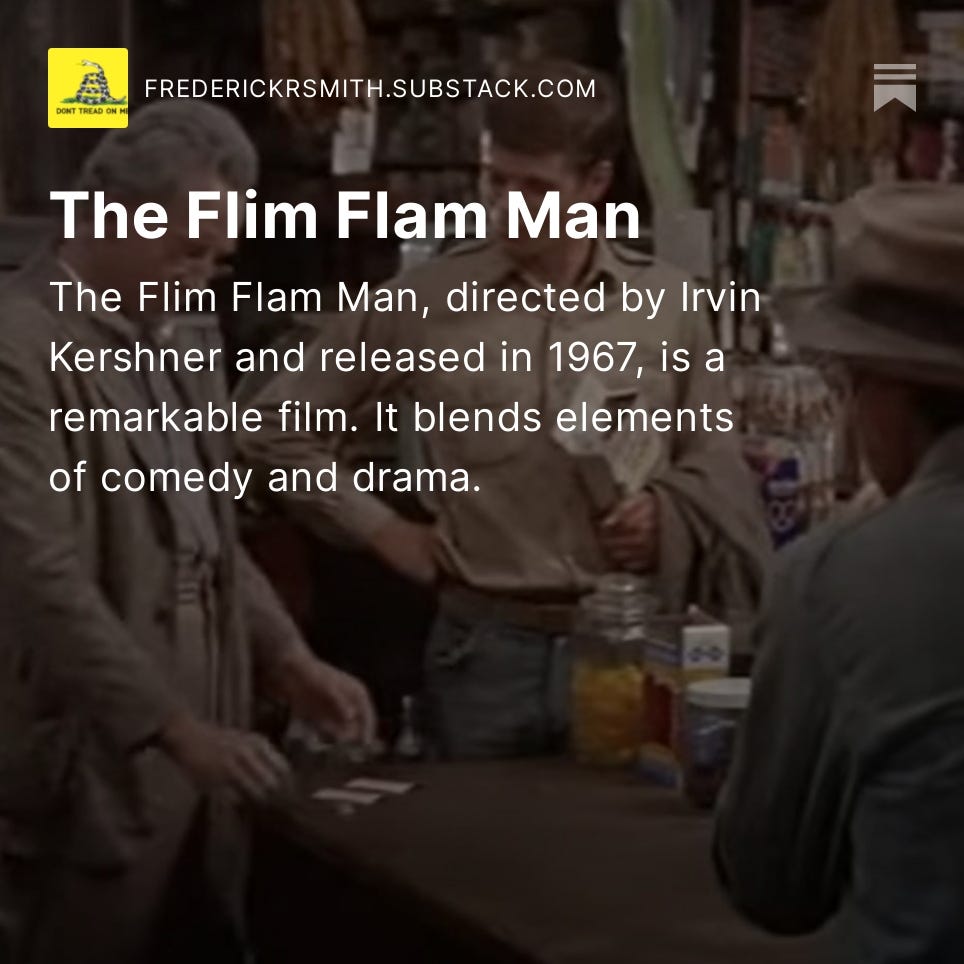
Great essay! The skill and depth to plots in older movies. Of course there were standouts like George C. Scott, but the depth of the bench of quality actors was also much deeper.
George C. Scott was a brilliant and evocative actor (in this movie, in DR. STRANGELOVE, in THEY MIGHT BE GIANTS, and in several others). Sadly, the FLIM FLAM MAN is not available for streaming and a new DVD costs over $100.00. Thanks for sharing the story.